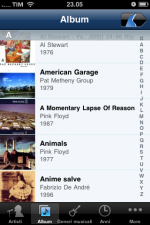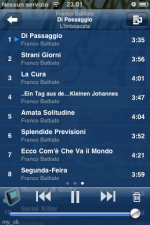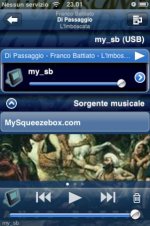As you can read in my blog. The flac issue is a pretty well known issue.
You need it decoded on a remote server. Then it's PCM streaming.
I'd recommend to work on your wired ethernet optimizations.
I slightly revised the ethernet chapter. Let see if we can squeeze even more out of it.
Cheers
You need it decoded on a remote server. Then it's PCM streaming.
I'd recommend to work on your wired ethernet optimizations.
I slightly revised the ethernet chapter. Let see if we can squeeze even more out of it.
Cheers
soundcheck,
may I ask a few questions?
Do you have any specific information supporting this statement? Where are the ground loops introduced when using unshielded cables?
In one part, you discuss quality of ethernet switch, in another one you suggest to use a complicated QoS router where all packets are inspected by an embedded CPU and the chances of dropping/delaying packets are much higher (but still entirely negligible, of course).
Joining a shielded cable and unshielded one can be via a simple ethernet junction.
may I ask a few questions?
Even though the ports are isolated by transformers, ground loops do exist.
Do you have any specific information supporting this statement? Where are the ground loops introduced when using unshielded cables?
In one part, you discuss quality of ethernet switch, in another one you suggest to use a complicated QoS router where all packets are inspected by an embedded CPU and the chances of dropping/delaying packets are much higher (but still entirely negligible, of course).
Joining a shielded cable and unshielded one can be via a simple ethernet junction.
soundcheck,
may I ask a few questions?
Do you have any specific information supporting this statement? Where are the ground loops introduced when using unshielded cables?
When using unshielded cables there are usually no groundloops.
There has been an article in the German "Stereo" magazine about the impact of ethernet cables. The winner , I think it was a "Monster", didn't have a shield either if a recall it correctly.
They concluded: There is an impact due to cables. But it is not the data of course. They also said one of the main reasons should be HF interferences
finding it's way into the device.
In one part, you discuss quality of ethernet switch, in another one you suggest to use a complicated QoS router where all packets are inspected by an embedded CPU and the chances of dropping/delaying packets are much higher (but still entirely negligible, of course).
The QoS router is supposed to give multimedia streams a higher priority on the net.
Consider the HUB as a kind of termination point in front of the Touch.
Joining a shielded cable and unshielded one can be via a simple ethernet junction.
Very constructive comment let's follow up on this one.
Don't forget to have a look at the mixed rates (100MBit vs. 1GBIT) in a Network.
The whole networking discussion I consider much more vague then the
Touch internal mods. Would be nice if the best solution comes out of this discussion. I'll change my proposal accordingly.
BTW. Do you have a Touch up'n running now?
Cheers
WLAN with SW mods
As already mentioned in comments on sounchecks blog I think with WLAN connection you could avoid mass loops caused by network wires. So it would be very interesting to have a SW mod. doing same as Soundchecks SW mods for wired connection but usable for WLAN.
As already mentioned in comments on sounchecks blog I think with WLAN connection you could avoid mass loops caused by network wires. So it would be very interesting to have a SW mod. doing same as Soundchecks SW mods for wired connection but usable for WLAN.
Recently I´ve downloaded this small applet for my Windows Mobile phone (HTC)
http://sc.sciatec.de/ This turns your mobile phone into a pretty fast remotecontrol for your SBT. It also allows you to have almost full control over your SBT with the display turned off. Which i think could be a better solution than unplugging the display, because the processor then actually turns of the displayprocesses. By unplugging the display, the processor might even try to do some handshake over and over, trying to get in control of the display.
The applet is not freeware, but will cost you 10€, which I find very modest for the convinience it provides.
I´m sure there are several others for other Mobile OS, such as Android, iPhone, Nokia etc.
Give it a go
http://sc.sciatec.de/ This turns your mobile phone into a pretty fast remotecontrol for your SBT. It also allows you to have almost full control over your SBT with the display turned off. Which i think could be a better solution than unplugging the display, because the processor then actually turns of the displayprocesses. By unplugging the display, the processor might even try to do some handshake over and over, trying to get in control of the display.
The applet is not freeware, but will cost you 10€, which I find very modest for the convinience it provides.
I´m sure there are several others for other Mobile OS, such as Android, iPhone, Nokia etc.
Give it a go
Yes, there's also for iphone a remote controller for SBT
Maybe that would also apply for the iPod and other iThings

Maybe that would also apply for the iPod and other iThings
yup!
Hi guys.
The display mod is not the same as turning the display of with the screensaver.
Just give it a try!
Cheers
Unfortunately that would bring the possibility to control the embedded squeezebox server software to an end.
And I would miss that a lot, since performance in my set-up is much better using an USB HDD than feeding via WLAN or ethernet. It is somewhat slower though, but that is a price I´m willing to pay for better SQ.
Using my HTC as remote speeds up reaction time from my SBT to an acceptable level, even though I´ve got pretty close to 1TB of music files.
So disconnecting the display does not seem to be an option for me.
Next experiment will be powering my HDD from a linear PSU.
Unfortunately that would bring the possibility to control the embedded squeezebox server software to an end.
And I would miss that a lot, since performance in my set-up is much better using an USB HDD than feeding via WLAN or ethernet. It is somewhat slower though, but that is a price I´m willing to pay for better SQ.
Using my HTC as remote speeds up reaction time from my SBT to an acceptable level, even though I´ve got pretty close to 1TB of music files.
So disconnecting the display does not seem to be an option for me.
Next experiment will be powering my HDD from a linear PSU.
There is no audio solution without compromises.
You'll win here, you'll loose there.
I considered the SD-card player solution as the potentially ultimate solution some months ago. I pretty quickly realized though that meanwhile the handling of my collection and the usage of great internet services like Last-FM in a home network environment gets higher priority then the last bit of sound quality.
With the modifications applied to the Touch I think I am doing more than fine in terms of SQ.
Cheers
There is no audio solution without compromises.
You'll win here, you'll loose there.
I considered the SD-card player solution as the potentially ultimate solution some months ago. I pretty quickly realized though that meanwhile the handling of my collection and the usage of great internet services like Last-FM in a home network environment gets higher priority then the last bit of sound quality.
With the modifications applied to the Touch I think I am doing more than fine in terms of SQ.
Cheers
As you think I should try to go for a modified ethernet solution, I think you ought also to try out the USB HDD solution, provided that the USB HDD has its own PSU.
A funny thing I can tell about ethernet streaming is, that I´ve experienced the same thing always. Last time was at my freinds place, where he streamed from a PC to his Denon AVP A1 HDA surrround reciever. The sound was harrassing me seriously, I simply hated it. Then he found the actual CD, which was ripped to his PC in uncompressed Wave format, he put in his bluray player, which was connected to the HDMI input of the Denon reciever.
Suddenly the world became a better place to be, there is no comparison regarding SQ in those two sources. Unfortunately I experienced the excact same when connecting the SBT, Ethernet/WLAN = NOGO, USB reacts the same way as his HDMI connection did.
Finally I´ve gotten the linear PSU for the USB HDD running.
It is just a variable PSU from a company called GW like this one Universal netdel 2000mA | BN051988 - Elektronik Lavpris ApS
I decoupled it with a 2.200µF ElCap paralleled by a polyester film cap @ 470 nF at the output pins.
Now the sound definately changed into a more direct sound with better resolution in the basic tone area, which means something around 150-1.000 Hz or so. Also bass resolution improved, and I thought well about it in the first place. But something annoying came up which pussled me pretty much. It was if a slight distortion on sibilance occurred now and then. Not always but on some recordings only.
I thought that this might actually be the recording, just now the recording flaws was being revealed. But after a while I thought, that if that was the case, I would prefer the old supply for the HDD.
But then with no special thought I just tried to pull out the original SMPS from the outlet - Bingo.
These SMPS supplies are so noisy, that they will pollute your power so much, that your set-up will react negatively upon it, even if it is unloaded.
So a good tip is not to connect anything powered by SMPS anywhere near your set-up, both as a part of the set-up or not.
Regarding connecting a PC, I did not try this out, but I think the result will be pretty much the same, regardless of which wall outlet is used, because noise is distributed through the ethernet cable itself. Transformers will not really do any difference on that matter.
Just my findings, and I love my SBT even more now.
It is just a variable PSU from a company called GW like this one Universal netdel 2000mA | BN051988 - Elektronik Lavpris ApS
I decoupled it with a 2.200µF ElCap paralleled by a polyester film cap @ 470 nF at the output pins.
Now the sound definately changed into a more direct sound with better resolution in the basic tone area, which means something around 150-1.000 Hz or so. Also bass resolution improved, and I thought well about it in the first place. But something annoying came up which pussled me pretty much. It was if a slight distortion on sibilance occurred now and then. Not always but on some recordings only.
I thought that this might actually be the recording, just now the recording flaws was being revealed. But after a while I thought, that if that was the case, I would prefer the old supply for the HDD.
But then with no special thought I just tried to pull out the original SMPS from the outlet - Bingo.
These SMPS supplies are so noisy, that they will pollute your power so much, that your set-up will react negatively upon it, even if it is unloaded.
So a good tip is not to connect anything powered by SMPS anywhere near your set-up, both as a part of the set-up or not.
Regarding connecting a PC, I did not try this out, but I think the result will be pretty much the same, regardless of which wall outlet is used, because noise is distributed through the ethernet cable itself. Transformers will not really do any difference on that matter.
Just my findings, and I love my SBT even more now.
Kurt.
You might have read on my blog that I recommend batteries as the ultimate supply option.
I put together over there - though I didn't tell how I got there - a solution which tries to eliminate all those traps your're coming up with here and then.
Anyhow you seem to be on a good way going into the right direction --- "Learning by Doing" -- it'll take a while but I 'm sure you'll get there.
But - pleezze - don't speculate like "Regarding connecting a PC, I did not try this out, but I think the result will be pretty much the same, regardless of which wall outlet is used....".
Read up my ethernet hints and try them. There is a good reason why I listed them up.
And I am sure that the "no monitor" tweak + "ethernet" tweak + "remote flac decoding"+ "no local server" will beat your self powered HDD approach.
Cheers
You might have read on my blog that I recommend batteries as the ultimate supply option.
I put together over there - though I didn't tell how I got there - a solution which tries to eliminate all those traps your're coming up with here and then.
Anyhow you seem to be on a good way going into the right direction --- "Learning by Doing" -- it'll take a while but I 'm sure you'll get there.
But - pleezze - don't speculate like "Regarding connecting a PC, I did not try this out, but I think the result will be pretty much the same, regardless of which wall outlet is used....".
Read up my ethernet hints and try them. There is a good reason why I listed them up.
And I am sure that the "no monitor" tweak + "ethernet" tweak + "remote flac decoding"+ "no local server" will beat your self powered HDD approach.
Cheers
Battery power is also pretty noisy but in other ways.
Simple Voltage Regulators Part 1: Noise
So i don´t think thats the way to go.
Everywhere I´ve heard battery powered hifi of any kind, it has been nogo.
Also the sound differs a lot from battery to battery, surely depending on output impedance, which is both high and non linear on batteries.
I´ll try out the ethernet solution soon, even though it from a theoretical point of view, does not look as attractive.
Simple Voltage Regulators Part 1: Noise
So i don´t think thats the way to go.
Everywhere I´ve heard battery powered hifi of any kind, it has been nogo.
Also the sound differs a lot from battery to battery, surely depending on output impedance, which is both high and non linear on batteries.
I´ll try out the ethernet solution soon, even though it from a theoretical point of view, does not look as attractive.
Battery power is also pretty noisy but in other ways.
Simple Voltage Regulators Part 1: Noise
So i don´t think thats the way to go.
Everywhere I´ve heard battery powered hifi of any kind, it has been nogo.
Also the sound differs a lot from battery to battery, surely depending on output impedance, which is both high and non linear on batteries.
I´ll try out the ethernet solution soon, even though it from a theoretical point of view, does not look as attractive.
Hint: Try a buffered 3.3V LiPoFe against a Paul Hynes or any other highly regarded voltage regulator. Then we can continue discussing noise issues.
Again, even if there'd be a noise issue associated to batteries, I consider interstage interferences/modulations the much worse compromise.
Not to forget the mains power supply is a highly reactive power source.
It is always about choosing the lesser of two evils. You need to find the best compromise for your chain. You always need to revise those compromises the further up you'll climb the ladder.
Cheers
Hint: Try a buffered 3.3V LiPoFe against a Paul Hynes or any other highly regarded voltage regulator. Then we can continue discussing noise issues.
Hi soundcheck,
How do you "buffer" the LiFePo4 batteries?
TIA
Hi soundcheck,
How do you "buffer" the LiFePo4 batteries?
TIA
What he means is putting a cap across the battery terminals to provide a reservoir from which charge can be drawn. In my opinion you don't need this with the A123 batteries & in fact you will probably degrade the performance of the batteries <8mOhm impedance. They are plenty fast enough on their own without caps & you will probably spend the same again if not more on a good quality cap so why bother!
What he means is putting a cap across the battery terminals to provide a reservoir from which charge can be drawn. In my opinion you don't need this with the A123 batteries & in fact you will probably degrade the performance of the batteries <8mOhm impedance. They are plenty fast enough on their own without caps & you will probably spend the same again if not more on a good quality cap so why bother!
The battery sits behind a switch, plug and perhaps even a fuse.
These do impact the performance. You should verify this.
A quality low ESR cap array ( Epcos Sikorel/Rifa) IMO still performs better then a plain battery.
Hint: You might also try a Bybee in the line.
Cheers
- Home
- Source & Line
- PC Based
- Squeezebox Touch -- Modifications


